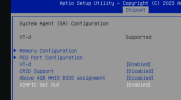Another Dell R340 Server here with the same problem booting to 6.5.11-7-pve. I tried updating intramfs as outlined earlier in this post and that did not help. I did not get a chance to boot with nomodeset as it's the end of my shift. This is after a pve 7to8 upgrade. NOTE: This was not listed in known issues!, which is annoying
Please let me know what information I can pull from the server to help debug this.
Please let me know what information I can pull from the server to help debug this.


